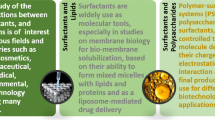Abstract
We compare the bimolecular quenching rate constant (k2) of luminescent tris(2,2′-bipyridine)ruthenium(II) by oxygen in water, ethylene glycol and glycerol as a function of temperature and viscosity to several theoretical models. The Smoluchowski equation with experimentally determined diffusion coefficients produced calculated values that were in the best agreement with experiment. For the less viscous solvent, water, this equation produced a value that was approximately an order of magnitude larger than the experimental value. With an increase in solvent viscosity, the Smoluchowski value approached the experimental value. Using the Smoluchowski equation with calculated diffusion coefficients based on the known radii of the reacting species produced deviations an order of magnitude larger in water and a factor of two or three lower in ethylene glycol and glycerol. If an assumption is made that the radii of both molecules are equal, we have the Stokes Einstein equation, and the only parameters become temperature and viscosity. Using this relationship, the calculated values for water are about a factor of two larger and with ethylene glycol and glycerol about a factor of 6 smaller than experimental data. These results show that bimolecular quenching is a more complex process affected by many parameters such as solvent cage effects in addition to viscosity and temperature.

Similar content being viewed by others
Reference
Lakowicz, JR (2006) Principles of fluorescence spectroscopy, Third Edition Springer Science+Business Media LL
Bowen EJ (1954) Fluorescence quenching in solution and in the vapor state. Trans Faraday Soc 50:97–102
Eftink MR, Ghiron CA (1987) Temperature and viscosity dependence of fluorescence quenching by oxygen in model systems. Photochem Photobiol 45(6):745–748
Hirayama S, Yasuda H, Scully AD, Okamoto M (1994) Study of the fractional power dependence on solvent viscosity of the rate constant for bimolecular diffusion-influenced quenching reactions between oxygen and the singlet and triplet states of anthracene derivatives. J Phys Chem 98(17):4609–4616
Morris KJ, Roach MS, Xu W, Demas JN, DeGraff BA (2007) Luminescence lifetime standards for the nanosecond to microsecond range and oxygen quenching of Ruthenium(II) complexes. Anal Chem 79:9310–9314
Tromans D (2000) Modeling oxygen solubility in water and electrolyte solutions. Ind Eng Chem Res 39:805–812
Kretschmer CB, Nowakowska J, Wiebe R (1946) Solubility of oxygen and nitrogen in organic solvents from −25° to 50°. Ind Eng Chem 38(5):506–509
Tian H, Chen K (1994) Solvent effect on the triplet lifetime of some rhodamine dyes. Dyes and Pigments 26:167–174
Jordan J, Ackerman E, Berger RL (1956) Polarographic diffusion coefficients of oxygen, defined by activity gradients in viscous media. J Am Chem Soc 78:2979–2983
Kampmeyer PM (1952) The temperature dependence of viscosity for water and mercury. J Appl Phys 23(1):99–102
Chen YM, Pearlstein AJ (1987) Viscosity-temperature correlation for glycerol-water solutions. Ind Eng Chem Res 26(8):1670–1672
Tsierkezos N, Molinou I (1998) Thermodynamic properties of water + ethylene glycol at 283.15, 293.15, 303.15, and 313.15 K. Chem Eng Data 43(6):989–993
Gijzeman OLJ, Kaufman F, Porter G (1973) Quenching of aromatic triplet states in solution by nitric oxide and other free radicals. J Chem Soc, Faraday Trans 2: Mol Chem Phys 69(Pt 5):727–737
Gijzeman OLJ, Kaufman F, Porter G (1973) Oxygen quenching of aromatic triplet states in solution. J Chem Soc, Faraday Trans 2: Mol Chem Phys 69(Pt 5):708–720
Demas JN, Harris EW, McBride RP (1977) Energy transfer from metal complexes to oxygen. J Am Chem Soc 99:3547–3551
Acknowledgements
We thank Kaleem Morris for his support and guidance and the Chemistry Department at the University of Virginia for support of this work.
Author information
Authors and Affiliations
Corresponding author
Rights and permissions
About this article
Cite this article
Reynolds, E.W., Demas, J.N. & DeGraff, B.A. Viscosity and Temperature Effects on the Rate of Oxygen Quenching of Tris-(2,2′-bipyridine)ruthenium(II). J Fluoresc 23, 237–241 (2013). https://doi.org/10.1007/s10895-012-1139-9
Received:
Accepted:
Published:
Issue Date:
DOI: https://doi.org/10.1007/s10895-012-1139-9




